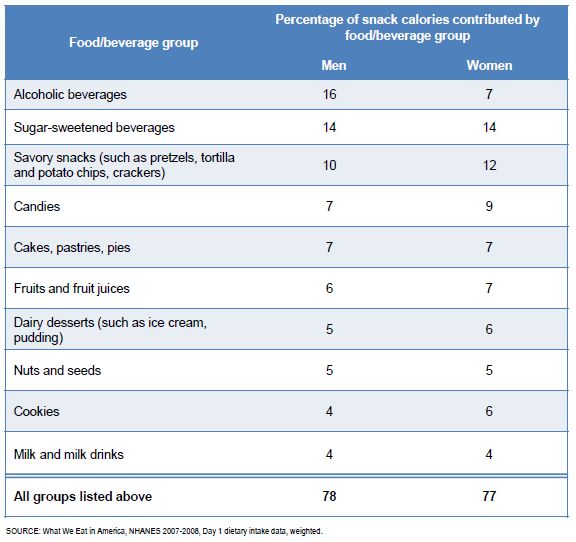Over the last 30 years, the average number of snacks consumed per day doubled, and the percentage of adults snacking on any given day rose from 59 to 90 percent. The high prevalence of overweight and obesity among the U.S. population has led researchers to evaluate possible associations between specific dietary patterns and weight status. Snacking is one dietary pattern which has been analyzed in this context. Previous research has indicated that snacking may contribute to higher intakes of calories, which in turn could lead to obesity. Besides the obvious risks of over-eating associated with snacking, there is also the issue of cost. Commercial snack foods (chips, pretzels, cookies, candy, etc.) are typically expensive and nutritionally empty.
Snacks provide on average about one-fourth of the daily calories, greater proportions of alcohol, carbohydrates and total sugars, and lesser proportions of most other nutrients. Overall, the foods and beverages contributing the most calories at snacks are not the most nutritious options. Between 1977-1978 and 2007-2008, significant increases have occurred in both the mean frequency of snacking (up from 1.0 to 2.2 snacks in a day) and the percentage of adults snacking on any given day (up from 59 percent to 90 percent), as shown in figure 1. On any given day in 1977-1978, most adults (73 percent) snacked only once or not at all. In 2007- 2008, about two-thirds of adults (65 percent) snacked two or more times in a day.
SOURCES: Nationwide Food Consumption Survey 1977-1978 and What We Eat in America, NHANES 2007-2008,
How many calories do adults obtain from snacks in a day?
Based on the WWEIA 2007-2008 survey, foods and beverages consumed at snacking occasions now contribute a daily average of 586 calories for men and 421 calories for women. Adults age 60 years and over consume fewer calories overall, and calories consumed at snacking occasions are lower for people in this age group than for younger groups (see figure 2). In addition, the proportion of daily calories provided by snacks is significantly smaller for older women (but not men) than for their younger counterparts.
On average, 24 percent of adults' total daily calories are consumed at snacking occasions. However, for some individuals, snacks provide a substantially larger proportion of daily calorie intake. Nearly 1 in 6 adults (16 percent) obtain over 40 percent of their total daily calories from foods and beverage they report as being consumed as snacks. Relative to their caloric contribution (marked by line X in figure 3 below), snacks provide higher proportions of adults' daily intakes of alcohol, carbohydrate, and total sugars (a subgroup of carbohydrate); similar proportions of vitamin C, vitamin E, calcium, and magnesium; and lower proportions of most other nutrients.
Higher snacking frequency is associated with higher total calorie intake. Adults who have 4 or more snacks in a day consume almost one and one-half times as many calories as do adults who report no snacks. However, the study also showed that the mean number of snacks consumed in a day does not differ significantly by weight status (see definition below) for either men or women.
Weight status: Adults were assigned to weight status categories based upon their calculated body mass index (BMI). As defined by the National Institutes of Health. Weight status categories and their associated BMI ranges are the following: Underweight, <18.5; normal weight, 18.5-24.9; overweight, 25.0-29.9; and obese, 30.0 and over.
So that must mean there is a difference in what healthy weight and overweight people eat for snacks. The categories of food/beverages used in this study include the following:
From this list the "Good" snacks would be: Fruits and Fruit Juices, Nuts and Seeds, Milk and Milk Drinks. Everything else on the list would be considered empty calories of little to no nutritional benefit.
Eating a nutritionally complete snack is not by itself a bad thing. In fact, one of the best things you can do if you are trying to lose body-fat and/or gain muscle mass is to eat a high-protein snack in between planned meals. There quite a bit of evidence that by spreading out your nutritional intake by eating every two-three hours you stabilize your blood sugar, prevent insulin spikes, and increase your metabolic rate by feeding your muscles. These are all good things.
So what can we conclude from this study? First, the rate of snacking and the percentage of our daily caloric intake attributed to snacking has increased significantly in the past thirty years (Coincidentally the same period that the national obesity rate started climbing.). Second, since there is little difference in the rate of snacking between "normal" weight and overweight adults, there must be a difference in what they snack on. My conclusion: Eating healthy snacks, up to several times a day, can be integrated into your diet with no corresponding gain in weight. It is not how often you eat but rather what you eat.
Healthy, nutritious snacks help you to avoid over eating during normal meal times. Since this balances out the cost of eating there is no net gain in your food budget if you integrate snacking into your daily nutritional intake. Swap out a half of a peanut butter and jelly on whole wheat bread for a handful of cookies, for example. Have a sliced apple instead of a cupcake. I use an apple slicer/corer, as seen below, to prepare my daily apple. It takes just a moment and then I have sliced apples in a plastic container to snack on during the day. If I am craving something a little more "unhealthy" I spread a little Hazelnut spread (Nutella in the states) on a slice.
Much of this information came from a report published by:
U.S. DEPARTMENT OF AGRICULTURE
Agricultural Research Service
Beltsville Human Nutrition Research Center
Food Surveys Research Group
Agricultural Research Service
Beltsville Human Nutrition Research Center
Food Surveys Research Group





No comments:
Post a Comment